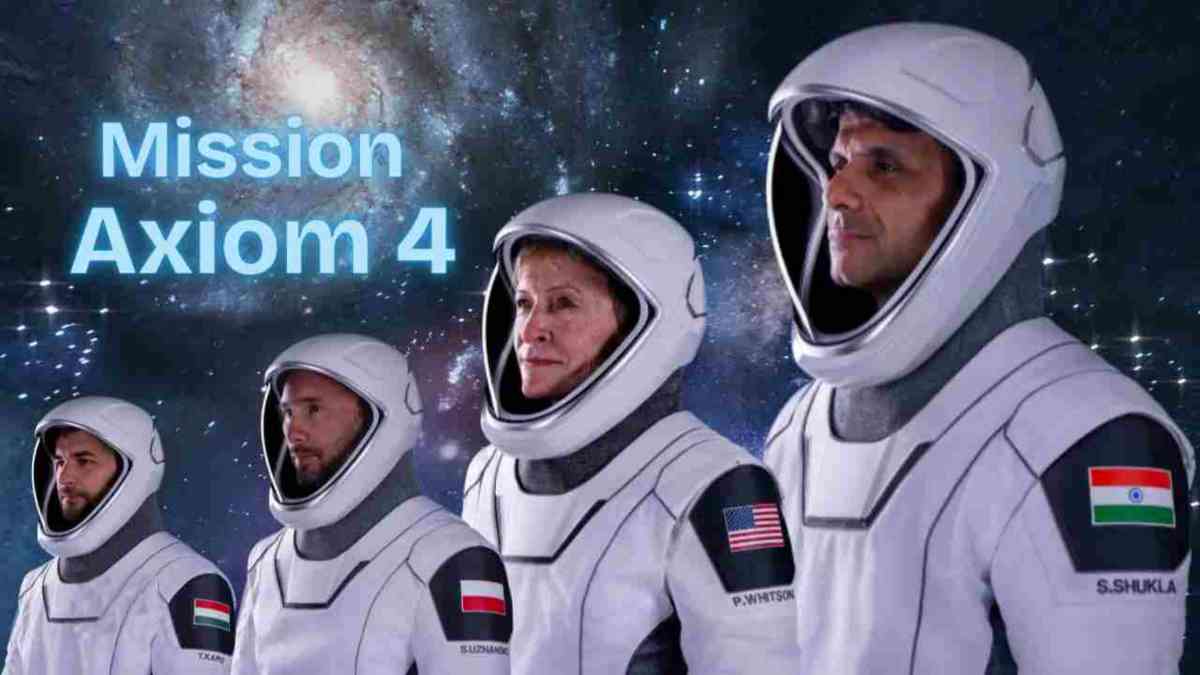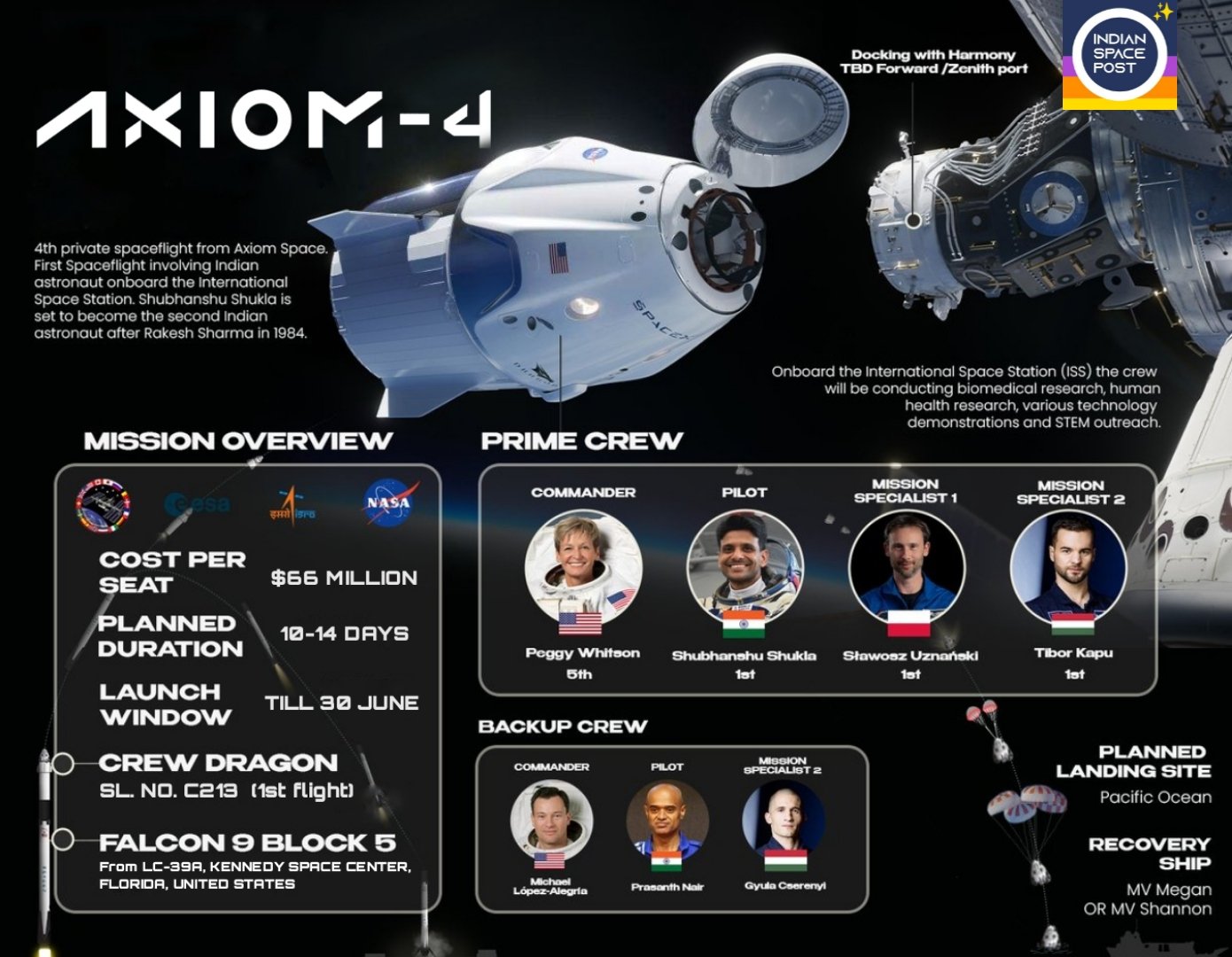India’s space journey has always been driven by big dreams and steady progress. From launching satellites to sending probes to the Moon and Mars, the country has shown that it can achieve remarkable feats with limited resources. Now, India is taking a major step forward by preparing for human spaceflight.
- The recent Axiom-4 mission, which carried an Indian astronaut Shubhanshu Shukla, to the International Space Station, is a milestone that goes beyond a single voyage. It shows how India is using international partnerships and commercial opportunities to learn faster, gain experience, and build confidence. This mission is not just about reaching space—it is about laying the groundwork for India’s future as a leading spacefaring nation.
- The experience gathered from Axiom-4 will directly support Gaganyaan, India’s own human spaceflight programme, and help develop the skills, technologies, and systems needed for more complex missions in the years ahead.
A New Model for Space Exploration:
- Axiom-4 is the fourth private astronaut mission conducted by NASA and Axiom Space, a leading commercial space company. This mission reflects the changing nature of space exploration, where private firms are increasingly taking up roles that were once the exclusive domain of government agencies.
- The four-member international crew included Commander Peggy Whitson from the United States, Shubhanshu Shukla as pilot from India, and mission specialists from Poland and Hungary. This diverse crew not only carried out scientific tasks but also demonstrated the growing spirit of global collaboration in space.
- SpaceX served as the launch provider. Its Falcon 9 rocket lifted off from Launch Complex 39A at Kennedy Space Center in Florida. About 16 hours after launch, the spacecraft docked with the ISS, starting a planned 14-day mission focused on scientific experiments.
Strategic Shift in India’s Approach:
- India’s participation in Axiom-4 highlights a new, pragmatic approach to building its space capabilities. Traditionally, countries depended on bilateral government agreements for astronaut flights. With NASA no longer sponsoring foreign astronaut missions, India turned to commercial space services. This decision reflects an understanding of the evolving global landscape where partnerships with private companies are essential for faster progress.
- ISRO was an equal partner in this mission. A large Indian team was present in the US to help plan, monitor, and troubleshoot during the final stages of preparation. The experience gained here will be invaluable as India works toward its indigenous Gaganyaan mission.
Scientific Experiments: Direct Relevance for Gaganyaan:
The mission is expected to carry out around 60 experiments representing 31 countries, with several studies designed to support the Gaganyaan programme:
· Microgravity Crop Growth: Indian scientists will assess how crops such as moong and methi germinate and grow in zero gravity. This research will help develop India-specific space food systems and identify robust plant varieties suitable for long-duration missions.
· Human Physiology: Studies will examine skeletal muscle dysfunction, cellular responses, and pathways of muscle loss in microgravity. These findings will inform health protocols to maintain astronaut fitness during extended stays and contribute to medical research for muscle-related diseases on Earth.
· Mental Health and Cognitive Performance: Experiments will explore how microgravity affects cognition, screen use, and stress. Insights will guide spacecraft interior design and psychological support systems.
· Life Support Systems: Investigations into cyanobacteria and microalgae will test their potential for producing oxygen, recycling waste, and supplying food on future spacecraft. This is directly linked to designing sustainable life-support systems for Gaganyaan and India’s planned space station.
International Space Station as a Learning Platform:
- The ISS, operating since 1998, orbits approximately 400 kilometres above Earth and is recognised as humanity’s premier laboratory in space. Managed by a coalition of NASA, Roscosmos, ESA, JAXA, and CSA, it has enabled thousands of scientific studies and trained multiple generations of astronauts.
- However, the ISS is nearing the end of its operational life, with controlled deorbiting planned by 2030–2031. This transition creates opportunities for commercial stations such as Axiom Station, which will initially attach to the ISS before becoming an independent platform. Accessing the ISS through missions like Axiom-4 provides India with vital real-world experience that will be impossible to replicate once the station is retired.
Significance for India:
Building Indigenous Capability through Gaganyaan: The Gaganyaan mission, approved in 2018, aims to demonstrate India’s independent human spaceflight capability. The programme is designed to send a three-member crew to a 400-kilometre low Earth orbit for up to three days. Initial uncrewed test flights are scheduled for the next few years, with the first crewed mission targeted by 2027.
Participation in Axiom-4 is expected to directly strengthen Gaganyaan in several operational areas:
· Pre-launch quarantine procedures and medical readiness
· Spacecraft ingress and egress protocols
· Microgravity health diagnostics
· Emergency procedures and contingency planning
· International mission coordination and operations
Long-Term Vision and Ambitions: India’s ambitions go far beyond the initial Gaganyaan flights. The Indian space programme envisions launching the first module of a national space station, the Bharatiya Antariksh Station, by 2028, with the station becoming fully operational by 2035. A crewed lunar mission is also planned by 2040. These milestones will place India among the few nations capable of independent human space operations across Earth orbit and the Moon.
Crossing the Karman Line on Axiom-4 represents the first step in this roadmap, providing operational insights and scientific data that will de-risk future missions.
Economic and Technological Impact: Human spaceflight is a catalyst for technological advancement and economic growth. The Gaganyaan mission already engages over 500 MSMEs and private enterprises supplying components, subsystems, and materials. This effort helps build a vibrant domestic space-tech ecosystem and generates skilled employment.
India currently accounts for about 2% of the $500 billion global space economy. The government’s vision aims to grow this share to 8% by 2033, expanding India’s space economy to approximately $44 billion. This growth will drive innovation in advanced materials, automation, artificial intelligence, and sustainable life-support technologies.
Diplomatic Leverage and Global Standing: The mission significantly raises India’s profile as an emerging space leader. Demonstrated human spaceflight capability serves as a powerful diplomatic tool, strengthening partnerships and opening new avenues of cooperation. Recent collaborations with Russia on astronaut training, France on life-support systems, and Australia on crew recovery underscore India’s commitment to proactive international engagement in space exploration.
Conclusion:
India’s participation in the Axiom-4 mission marks a decisive step toward achieving independent human spaceflight. By embracing commercial partnerships, India is accelerating the development of critical skills, validating technologies, and preparing a new generation of space professionals. The scientific experiments will enrich knowledge vital for Gaganyaan and future missions, while the operational lessons will help ensure mission safety and success.
As the nation looks ahead to a national space station and a crewed lunar landing, this experience will remain a cornerstone of India’s progress in space. The momentum generated is expected to inspire youth, strengthen technological capability, and position India as a major space power in the decades to come.
| Main question: India’s participation in the Axiom-4 mission represents a significant shift in its approach to human spaceflight. Discuss how leveraging commercial space missions can accelerate indigenous capability development. Also, highlight the technological and operational learnings relevant for the Gaganyaan programme. |








